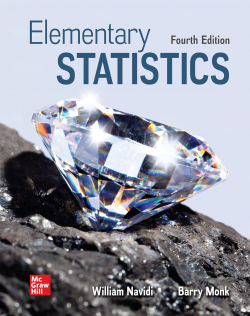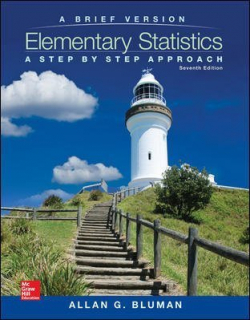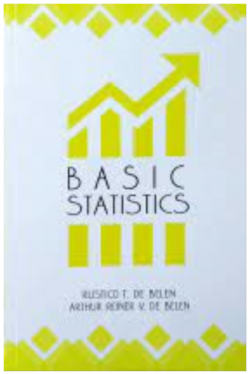Elementary statistics

Buy online ($)
Type
Book
ISBN 13
9789715428262
Category
Filipiniana-Circ.
[ Browse Items ]
Publication Year
2010
Publisher
University of the Philippines Press, Philippines
Pages
xiv, 698 p. : ill.
Subject
1. Mathematical statistics. 2. Mathematical statistics--Study and teaching. 3. Statistics.
Tags
Abstract
"Statistical thinking will one day be necessary for efficient citizenships as the ability to read and write." -H.G. Wells
These prophetic words of H.G. Wells inspired us to write a textbook for an introductory course in statistics. We believe that the day the renowned author was referring to has already arrived. We are now surrounded by data that were collected, analyzed, and presented using statistics. if we wish to take full advantage of this available information then there is no more escaping from the necessity of learning at least the elementary concepts of statistics.
Just imagine a world without statistics. This will be difficult to do since statistics is now an integral part of everyone's life. For instance, we will find it hard to assess student's overall academic performance at the end of each semester without summarizing the student's grades using the general weighted average. Even the enjoyable activity of watching our favorite sport on television will be half as fun without knowing the basketball player's statistics such as the free throw percentage, field goal percentage, rebound rate, or the baseball player's statistic such as the batting average. We will also be clueless on the general sentiment of people on current issues or the overall economic state of our country without knowing the results of surveys that are commonly reported by the media. There can be an endless litany of situations showing that statistics has a direst and practical application to all of us.
Furthermore, we believe that to prepare the Filipino for the 21st century, all universities must strengthen and cultivate the culture of research, not only in academic but among their students as well. Every student must learn to appreciate the role of research in discovering new knowledge and achieving breakthroughs in the different branches of science and the social sciences. To reach this goal, it is imperative that every student acquire the basic knowledge of the tools used in research--one of which is statistics. Therefore, a course on Elementary Statistics is an important prerequisite course on research in any specific field of study.
It is not our aim to turn every student into a statistician. Our primary concern is for students to develop statistical thinking and realize its importance in solving practical problems in their own fields, We want the students to learn the language of statistics first and then understand the statistical approach to answering a research problem. This means that we will have to discuss the fundamental principles and methods used in collecting, presenting, organizing, analyzing, and interpreting the data that will be used is a scientific investigation.
We organized this textbook by following the course outline of most Elementary Statistics courses. Chapter 1 introduces statistics as a branch of science used in research and the basic concepts such as the concept of a population and a sample. Chapter 2 focuses on methods of data collection. Chapter 3 presents introduction to sampling and sampling techniques. Chapters 4 & 5 discus methods of presenting and organizing data, respectively. Chapters 6 to 9 give a comprehensive discussion of different descriptive summary measures, including various measures of skewness and kurtosis. We can consider chapters 10 ad 11 as transitional chapters that will help students understand and appreciate the methods used in applied statistics. These chapters are the topics under mathematical statistics, namely, probability theory and sampling distributions. Finally, we devote chapters 12 to 18 to methods used in analyzing data. These data will allow students to perform simple statistical analysis and interpret the results of the analysis. It of course impossible to discuss all methods of statistical analysis in these chapters. What is more important is that we lay out the foundation needed in understanding inferential statistics.
One of the features of this textbook is the inclusion of substantive examples to illustrate new concepts and methods and to show the applications of the procedures in actual practice. As much as possible, we used Philippine data in our examples. We also deliberately selected examples of applications in the different disciplines.
In this book, we will introduce students to the Philippine Statistical System (PSS), the producer of government and official statistics. We want students to realize that the PSS is a rich source of reliable data that they can use in their own researches. So that the students become even more familiar with the PSS, we used actual surveys of the PSS in many of our examples.
We recognize the importance of exercises in truly comprehending the techniques. For this reason, we included exercises at the end of the different sections of each chapter. We also provided answers to selected exercises at the last part of the book.
This textbook provides enough material to allow for flexibility on the mathematical level needed to study the course. We presented the mathematical derivation of some of the properties and theorems in this book at the appendix of the chapter where the theorem appears. We separated the presentation of these proofs from the main text so that readers who are only interested in the applications of these theorems would not have to see these proofs. We realize that these proofs can sometimes be intimidating to the readers.
We included a short instruction manual on how to use Microsoft Excel in computing for some of the statistics that we discussed in this book. We incorporated actual outputs of Excel in the main test and discussed their interpretation.
We wish to thank all our colleagues, families, and friends for all their support in the completion of this book. In particular, we are grateful to our beloved parents-- Artemio and Aurora Venegas, Lorenzo Jr. and Fe Garcia, Cesar and Letty Capistrano, and Gorgonio Jr. and Tarcila Sarte; our dearest partners in life-- Joel, Noel, and Mr. L; and our adorable children-Janine, Josiel, Jam, Renzo, Sandro and the future Little Xs. We are indebted to the faculty and staff of the School of Statistics, UP Diliman, and the people of the National Statistics Office, particularly Administrator Carmelita Ericta, for all their help. Above all, we are eternally thankful to our Almighty Lord and Creator, the treasure house of wisdom and knowledge, who has served as our inspiration and constant guide.
-Josefina V. Almeda
Therese G. Capistrano
Genelyn Ma. F. Sarte
These prophetic words of H.G. Wells inspired us to write a textbook for an introductory course in statistics. We believe that the day the renowned author was referring to has already arrived. We are now surrounded by data that were collected, analyzed, and presented using statistics. if we wish to take full advantage of this available information then there is no more escaping from the necessity of learning at least the elementary concepts of statistics.
Just imagine a world without statistics. This will be difficult to do since statistics is now an integral part of everyone's life. For instance, we will find it hard to assess student's overall academic performance at the end of each semester without summarizing the student's grades using the general weighted average. Even the enjoyable activity of watching our favorite sport on television will be half as fun without knowing the basketball player's statistics such as the free throw percentage, field goal percentage, rebound rate, or the baseball player's statistic such as the batting average. We will also be clueless on the general sentiment of people on current issues or the overall economic state of our country without knowing the results of surveys that are commonly reported by the media. There can be an endless litany of situations showing that statistics has a direst and practical application to all of us.
Furthermore, we believe that to prepare the Filipino for the 21st century, all universities must strengthen and cultivate the culture of research, not only in academic but among their students as well. Every student must learn to appreciate the role of research in discovering new knowledge and achieving breakthroughs in the different branches of science and the social sciences. To reach this goal, it is imperative that every student acquire the basic knowledge of the tools used in research--one of which is statistics. Therefore, a course on Elementary Statistics is an important prerequisite course on research in any specific field of study.
It is not our aim to turn every student into a statistician. Our primary concern is for students to develop statistical thinking and realize its importance in solving practical problems in their own fields, We want the students to learn the language of statistics first and then understand the statistical approach to answering a research problem. This means that we will have to discuss the fundamental principles and methods used in collecting, presenting, organizing, analyzing, and interpreting the data that will be used is a scientific investigation.
We organized this textbook by following the course outline of most Elementary Statistics courses. Chapter 1 introduces statistics as a branch of science used in research and the basic concepts such as the concept of a population and a sample. Chapter 2 focuses on methods of data collection. Chapter 3 presents introduction to sampling and sampling techniques. Chapters 4 & 5 discus methods of presenting and organizing data, respectively. Chapters 6 to 9 give a comprehensive discussion of different descriptive summary measures, including various measures of skewness and kurtosis. We can consider chapters 10 ad 11 as transitional chapters that will help students understand and appreciate the methods used in applied statistics. These chapters are the topics under mathematical statistics, namely, probability theory and sampling distributions. Finally, we devote chapters 12 to 18 to methods used in analyzing data. These data will allow students to perform simple statistical analysis and interpret the results of the analysis. It of course impossible to discuss all methods of statistical analysis in these chapters. What is more important is that we lay out the foundation needed in understanding inferential statistics.
One of the features of this textbook is the inclusion of substantive examples to illustrate new concepts and methods and to show the applications of the procedures in actual practice. As much as possible, we used Philippine data in our examples. We also deliberately selected examples of applications in the different disciplines.
In this book, we will introduce students to the Philippine Statistical System (PSS), the producer of government and official statistics. We want students to realize that the PSS is a rich source of reliable data that they can use in their own researches. So that the students become even more familiar with the PSS, we used actual surveys of the PSS in many of our examples.
We recognize the importance of exercises in truly comprehending the techniques. For this reason, we included exercises at the end of the different sections of each chapter. We also provided answers to selected exercises at the last part of the book.
This textbook provides enough material to allow for flexibility on the mathematical level needed to study the course. We presented the mathematical derivation of some of the properties and theorems in this book at the appendix of the chapter where the theorem appears. We separated the presentation of these proofs from the main text so that readers who are only interested in the applications of these theorems would not have to see these proofs. We realize that these proofs can sometimes be intimidating to the readers.
We included a short instruction manual on how to use Microsoft Excel in computing for some of the statistics that we discussed in this book. We incorporated actual outputs of Excel in the main test and discussed their interpretation.
We wish to thank all our colleagues, families, and friends for all their support in the completion of this book. In particular, we are grateful to our beloved parents-- Artemio and Aurora Venegas, Lorenzo Jr. and Fe Garcia, Cesar and Letty Capistrano, and Gorgonio Jr. and Tarcila Sarte; our dearest partners in life-- Joel, Noel, and Mr. L; and our adorable children-Janine, Josiel, Jam, Renzo, Sandro and the future Little Xs. We are indebted to the faculty and staff of the School of Statistics, UP Diliman, and the people of the National Statistics Office, particularly Administrator Carmelita Ericta, for all their help. Above all, we are eternally thankful to our Almighty Lord and Creator, the treasure house of wisdom and knowledge, who has served as our inspiration and constant guide.
-Josefina V. Almeda
Therese G. Capistrano
Genelyn Ma. F. Sarte
Description
Contents:
Chapter 1: Introduction
Chapter 2: Collection of data
Chapter 3: Sampling and sampling techniques
Chapter 4: Presentati0on of data
Chapter 5: Organization of data
Chapter 6: Measures of central tendency
Chapter 7: Measures of location
Chapter 8: Measures of dispersion
Chapter 9: Measures of skewness and kurtosis
Chapter 10 Introduction to probability theory
Chapter 11: Sampling distributions]
Chapter 12: Exploratory data analysis]
Chapter 13: Estimation: Single population
Chapter 14: Estimation: Two populations
Chapter 15: Tests of hypothesis: Single population
Chapter 16: Tests of hypothesis: two population
Chapter 17: Chi-square tests
Chapter 18: Linear regression analysis.
Chapter 1: Introduction
Chapter 2: Collection of data
Chapter 3: Sampling and sampling techniques
Chapter 4: Presentati0on of data
Chapter 5: Organization of data
Chapter 6: Measures of central tendency
Chapter 7: Measures of location
Chapter 8: Measures of dispersion
Chapter 9: Measures of skewness and kurtosis
Chapter 10 Introduction to probability theory
Chapter 11: Sampling distributions]
Chapter 12: Exploratory data analysis]
Chapter 13: Estimation: Single population
Chapter 14: Estimation: Two populations
Chapter 15: Tests of hypothesis: Single population
Chapter 16: Tests of hypothesis: two population
Chapter 17: Chi-square tests
Chapter 18: Linear regression analysis.
Biblio Notes
Notes:
Includes bibliographical references
Includes bibliographical references
Number of Copies
5
| Library | Accession No | Call No | Copy No | Edition | Location | Availability |
|---|---|---|---|---|---|---|
| Main | 400 | Fil-C. QA276 A46 2010 | 1 | Filipiniana Section | Yes | |
| Main | 401 | Fil-C. QA276 A46 2010 | 2 | Filipiniana Section | Yes | |
| Main | 402 | Fil-C. QA276 A46 2010 | 3 | Filipiniana Section | Yes | |
| Main | 403 | Fil-C. QA276 A46 2010 | 4 | Filipiniana Section | Yes | |
| Main | 404 | Fil-C. QA276 A46 2010 | 5 | Filipiniana Section | No |




